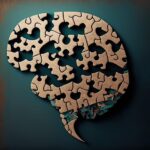Introduction
Alzheimer’s Disease and related dementias are a testament to the enigmatic workings of the human brain. As the most diagnosed form of dementia, Alzheimer’s Disease has a pervasive impact on memory, thinking, and behavior is unmistakable. Yet, behind the symptomatic veil lies a complex mosaic of causes, from biological to environmental. Understanding these underlying factors is not just an academic endeavor; it’s a crucial step in our collective journey towards developing effective treatments and preventive strategies that can alter the course of this debilitating disease.
Biological Mechanisms Behind Alzheimer’s Disease
Alzheimer’s Disease, standing at the forefront of neurodegenerative conditions, has long been a subject of intensive research. Delving into its biological underpinnings reveals a complex interplay of factors that contribute to its onset and progression.
Central to the Alzheimer’s narrative is the role of beta-amyloid plaques. These protein clusters build up between nerve cells in the brain, disrupting neuron communication. Unlike benign protein clusters, these plaques trigger immune system responses, leading to inflammation and the eventual death of neurons. Their accumulation is believed to play a pivotal role in the cognitive decline characteristic of Alzheimer’s.
Another key player in this biological saga is the formation of tau tangles. Tau, a protein, in its normal state, helps in the transportation of nutrients and other essential molecules within nerve cells. However, in Alzheimer’s, tau proteins twist into abnormal tangles, leading to the failure of the transport system and, subsequently, the death of nerve cells.
Beyond these tangible protein abnormalities, chronic inflammation emerges as a significant factor. While short-term inflammation is the body’s defense mechanism against injury or infection, chronic inflammation in the brain can be destructive. Persistent inflammation, especially around beta-amyloid plaques, exacerbates brain cell damage, accelerating the progression of Alzheimer’s.
Lastly, one cannot discuss Alzheimer’s without acknowledging the influence of genetics. Certain genes, when inherited, increase the likelihood of developing Alzheimer’s. For instance, the APOE-e4 gene variant is known to increase Alzheimer’s risk. While not deterministic, these genetic factors elevate susceptibility, especially when combined with environmental and lifestyle factors.
In understanding these biological mechanisms, we gain invaluable insights into the inner workings of a brain with Alzheimer’s. Such knowledge not only demystifies the disease but also provides avenues for potential treatments, bringing hope to millions affected by this condition.
Causes of Related Dementias
While Alzheimer’s Disease often dominates discussions around dementia, several other forms manifest distinct causes and symptom profiles. Understanding these dementias is paramount for accurate diagnosis and tailored interventions.
- Vascular Dementia is primarily associated with problems in the blood vessels that feed the brain. Reduced blood flow, often resulting from strokes or other cardiovascular complications, can deprive brain cells of vital nutrients and oxygen. This deprivation leads to cell death and, consequently, cognitive decline. Unlike Alzheimer’s, the onset of Vascular Dementia might be sudden, following a significant stroke, or gradual after a series of smaller strokes.
- Lewy Body Dementia gets its name from the presence of Lewy bodies, abnormal protein aggregates, in the brain. These protein deposits impact the brain’s functioning, leading to symptoms that can resemble both Alzheimer’s and Parkinson’s Disease. Notably, people with Lewy Body Dementia often experience visual hallucinations, as well as motor symptoms like a shuffling walk or tremors, reminiscent of Parkinson’s.
- Frontotemporal Dementia is a result of degeneration in the frontal and temporal lobes of the brain. While the exact cause remains elusive, potential genetic mutations have been linked to some cases. This form of dementia, instead of initially affecting memory, impacts personality, behavior, and language. Individuals might exhibit profound personality changes, impulsivity, or even neglect personal hygiene.
- Mixed Dementia underscores the complexity of dementia diagnosis. Here, individuals exhibit symptoms of both Alzheimer’s and another type of dementia, like Vascular or Lewy Body Dementia. This overlap makes diagnosis challenging, necessitating comprehensive evaluations to discern the contributing factors.
In shedding light on these related dementias, we recognize the intricate tapestry of cognitive disorders that affect millions worldwide. As research progresses, our understanding of these conditions deepens, offering hope for more effective treatments and interventions in the future.
Environmental and Lifestyle Factors
The intricate web of factors contributing to dementias extends beyond just genetics and biology. Environmental influences and lifestyle choices play a crucial role, either elevating the risk or offering a protective shield against these cognitive disorders.
Head trauma, particularly repeated injuries, has emerged as a significant risk factor. Individuals who have experienced multiple concussions or traumatic brain injuries might have an elevated risk of developing conditions like Chronic Traumatic Encephalopathy (CTE), which shares similarities with Alzheimer’s. This link underscores the importance of protective measures in contact sports and areas prone to accidents.
Cardiovascular health is inextricably linked to brain health. Heart health factors such as hypertension, high cholesterol, and diabetes can compromise blood flow to the brain, laying the groundwork for conditions like Vascular Dementia. Managing these factors through medication and lifestyle changes can significantly reduce dementia risk.
Chronic exposure to certain toxins or chemicals also raises alarms. Some studies suggest that prolonged exposure to heavy metals like lead, or pesticides, might be associated with an increased risk of dementias. While research in this area is ongoing, it emphasizes the need for safety measures in occupational settings and reduced environmental pollution.
On a brighter note, certain lifestyle choices can act as bulwarks against dementias. A balanced diet, rich in omega-3 fatty acids, antioxidants, and low in saturated fats, has shown promise in cognitive health preservation. Regular physical activity enhances blood flow to the brain, potentially delaying cognitive decline. Furthermore, cognitive engagement, be it through puzzles, reading, or learning new skills, keeps the brain active and resilient.
In understanding these environmental and lifestyle factors, we gain agency in our battle against dementias. By making informed choices, we not only improve our overall well-being but also fortify our defenses against cognitive disorders.
Conclusion
The narrative of Alzheimer’s and related dementias is one of interwoven threads, where genetics, biology, environment, and lifestyle converge in a dance of complexity. This interconnectedness underscores the imperative for a multifaceted, holistic approach in both research and treatment. As we stand at the crossroads of discovery, the clarion call resonates louder than ever – for rigorous research, for societal awareness, and for compassionate support. Together, armed with knowledge and united in purpose, we can confront the rising tide of these conditions, fostering hope for cures, interventions, and a dementia-free future.





















